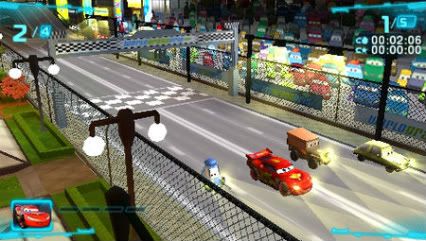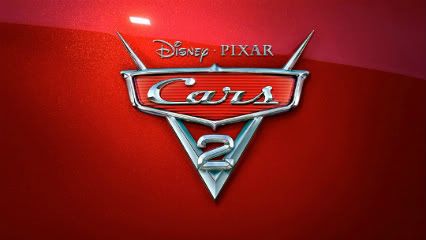- Platform: PSP (also available on other platforms)
- Unleashed: Out Now
- Publisher: Sony Computer Entertainment
- Developer: Virtual Toys
- Players: 1 (2 via local multiplayer)
- Site: http://uk.playstation.com/psp/games/detail/item395065/Cars-2-The-Video-Game/
The poor old PSP may be on the way out – especially with the industry getting excited at the sight of the shiny new PS Vita on the horizon – but it’s not going to go down without a fight. Cars 2 is the latest multiformat title to help plump up the PSP game library; but what do you get once you scrape off the Disney movie license?
First impressions are good. There’s a quality CG intro to get you in the mood for mildly anthropomorphised automobiles, and the car selection screen reveals a generous selection of over 20 characters from the film (though most need to be unlocked). They all look exactly as they should and, though the voice cast seems to be a mix of original and stand-ins, the mimics do a very good job. Unfortunately, the further the game strays from the superficial Disney presentation, the more it struggles to cling on to the player’s attention.
The structured part of the game is a series of missions from the C.H.R.O.M.E organisation of the film. These missions therefore act as a story mode. We say ‘act as’ rather than ‘make’, as the only attempt to tell a story is via text and stock illustrations on the loading screens between missions (and the looong loading times ensure you’ll have plenty of time to read). In fact, even using the word ‘missions’ is disingenuous; more accurately, what we have here is a series of races.
 There are five types of race. Battle Race is, in theory, the main attraction; though only a small portion of the races use this mode. Think Mario Kart and you’ll immediately have the basic idea. Race around the track for X amount of laps against opponents, using weapons randomly assigned from boxes you drive through to slow them down whilst avoiding or jumping over obstacles. You also have a four segment energy bar, filled with separate pickups. You can use each segment for either a speed boost or brief invulnerability to attacks (but not crashes); or save up all four for a longer, faster boost. Several problems conspire to stop this being as fun as it might sound.
There are five types of race. Battle Race is, in theory, the main attraction; though only a small portion of the races use this mode. Think Mario Kart and you’ll immediately have the basic idea. Race around the track for X amount of laps against opponents, using weapons randomly assigned from boxes you drive through to slow them down whilst avoiding or jumping over obstacles. You also have a four segment energy bar, filled with separate pickups. You can use each segment for either a speed boost or brief invulnerability to attacks (but not crashes); or save up all four for a longer, faster boost. Several problems conspire to stop this being as fun as it might sound.
Firstly, the isometric 3D perspective used – as opposed to a behind the car and/or cockpit view – can be problematic. It gives the (certainly intentional) impression of toy cars racing round a toy racetrack, and there’s nothing wrong with that. The combination of highly detailed backgrounds and a vaguely cinematic camera that swings round corners proves to be a double edged sword, however. As previously mentioned, there are obstacles; obstacles that force a restart no matter how fast or slow you were travelling when you hit them (thankfully, the spawn points are never more than a few steps back). Some are too tall to be jumped, and the choice of perspective means you sometimes only have a split second to swerve. Worst of all, a few tracks feature foreground details that, on occasion, obscure such obstacles until you’re a nanosecond aware from being a cheerily designed car wreck.
These races only ever feature four cars – including yours. Presumably this, and the young audience in mind for the game, influenced the decision to resurrect the practice of ‘rubberbanding’ that has been all but killed in the games of today. This means that if you fall behind, the other cars will politely slow right down until you catch up. We once deliberately crashed into the same obstacle several times, yet caught up with the race in a matter of seconds (on the highest difficulty). It also means that, no matter how careful you are to avoid crashing and no matter how well you use your boosts, at least one car will magically catch up with you if it looks like you’re in danger of making a decent lead for yourself.
 Race is the same setup without weapons, while Against the Clock is basically a checkpoint run. Eliminator knocks out the racer in last place at the end of each lap, and Attack… Attack has the most potential. Here you go round and round the track until time runs out, destroying as many infinitely spawning ‘lemons’ (er, yellow cars) as you can. Each race has bronze, silver and gold trophies to be won (the game also has ‘badges’ in lieu of PSN trophies) and achieving gold in some of the Attack races actually presents a challenge. Although the idea is very simple, it requires more skill than the other modes. You’ll need to keep a close eye on when and where the lemons turn and swerve – to ensure that your attacks don’t miss – as well as watching for turns and obstacles as usual.
Race is the same setup without weapons, while Against the Clock is basically a checkpoint run. Eliminator knocks out the racer in last place at the end of each lap, and Attack… Attack has the most potential. Here you go round and round the track until time runs out, destroying as many infinitely spawning ‘lemons’ (er, yellow cars) as you can. Each race has bronze, silver and gold trophies to be won (the game also has ‘badges’ in lieu of PSN trophies) and achieving gold in some of the Attack races actually presents a challenge. Although the idea is very simple, it requires more skill than the other modes. You’ll need to keep a close eye on when and where the lemons turn and swerve – to ensure that your attacks don’t miss – as well as watching for turns and obstacles as usual.
There are only 25 ‘missions’ (including the tutorial) and, no matter the chosen difficulty (which can’t be changed) and age of the player, virtually everybody will get through them all in no more than 3-4 hours. The ending encourages you to achieve gold in them all if you haven’t already, but it’s questionable how many will be interested enough. That aside, there is only Free Play – where you choose the mode and track for yourself – and multiplayer. We were unable to test the multiplayer element, being as it is local only. This seems like a real missed opportunity, as online play would have added a whole new – and likely much more attractive – dimension to the experience.
This game only does a few things particularly wrong, but the main problem is that it does nothing particularly right. Things are perhaps best summed up in the way the sixteen tracks have been designed. Visually they’re very well done, with the London areas being a particular highlight. They all feel the same though, sharing the same hazards, basic layouts and game modes. After half a dozen tracks you have, in essence, played the whole game.




Comments